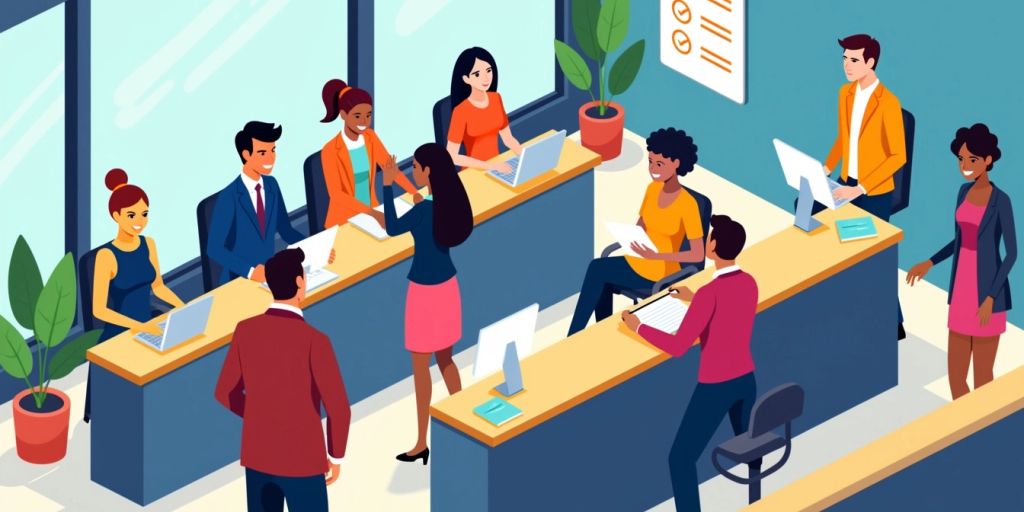Mastering communication in customer service is essential for creating positive experiences and building lasting relationships with customers. This article outlines key strategies that can help businesses enhance their customer service communication, ensuring that customers feel valued and understood. By implementing these strategies, companies can improve customer satisfaction and loyalty, ultimately driving business success.
Table of Contents
ToggleKey Takeaways
- Create a clear communication plan that reflects your brand’s voice and meets customer needs.
- Focus on building long-term relationships by turning mistakes into opportunities and rewarding loyalty.
- Use technology wisely to provide quick support while maintaining a personal touch.
- Tailor interactions by understanding customer history and preferences to anticipate their needs.
- Invest in training and clear roles for your customer service team to ensure effective support.
Building a Comprehensive Communication Strategy
Creating a strong communication strategy is essential for effective customer service. Understanding your customers’ needs is the first step. This means knowing where they like to communicate, whether it’s through email, social media, or other channels. Here are some key points to consider:
Understanding Your Brand Voice
- Your brand voice should reflect your company’s values.
- It should be consistent across all platforms.
- Make sure it resonates with your target audience.
Aligning Tone with Customer Needs
- Adjust your tone based on the situation. For example, a friendly tone works well for casual inquiries, while a more formal tone may be needed for complaints.
- Listening to customer feedback can help you refine your tone.
- Always aim for clarity and empathy in your messages.
Incorporating Company Style
- Use a style guide to maintain consistency in communication.
- Train your team on the company’s communication style.
- Regularly review and update your style guide based on customer interactions.
A well-defined communication strategy not only enhances customer satisfaction but also builds trust and loyalty.
By focusing on these areas, you can create a comprehensive communication strategy that meets your customers’ needs and expectations. This approach will help you deliver a consistent and positive experience across all channels, ultimately leading to better customer relationships and satisfaction.
| Communication Channel | Customer Preference (%) |
|---|---|
| 80% | |
| Social Media | 15% |
| Phone | 5% |
Developing Long-Term Customer Relationships

Building strong connections with customers is essential for any business. Creating lasting relationships can lead to customer loyalty and satisfaction. Here are some strategies to help you develop these important connections:
Transforming Errors into Positive Experiences
- When mistakes happen, it’s crucial to address them quickly.
- Offer solutions that make the customer feel valued.
- Use errors as a chance to show your commitment to service.
Implementing Loyalty Programs
- Reward customers for their continued support.
- Consider offering discounts, exclusive offers, or points for purchases.
- Make sure the program is easy to understand and use.
Offering Compensation for Inconveniences
- If a customer faces an issue, consider providing compensation.
- This could be in the form of refunds, discounts, or free services.
- Compensation can turn a negative experience into a positive one.
Building long-term relationships with customers is not just about making a sale; it’s about creating a bond that encourages them to return.
By focusing on these strategies, businesses can foster loyalty and ensure that customers feel appreciated and valued. This approach not only enhances customer satisfaction but also contributes to the overall success of the business.
Leveraging Technology for Fast Support
In today’s fast-paced world, using technology effectively can greatly enhance customer support. Modern tools can streamline processes and help teams respond quickly to customer needs.
Balancing Automation and Human Interaction
- Automation can handle repetitive tasks, such as sending confirmation emails or follow-up messages.
- However, some situations require a human touch, like live chats or complex inquiries.
- Finding the right balance between automated responses and personal interaction is crucial for customer satisfaction.
Utilizing Modern Tools for Efficiency
- Implementing tools like chatbots can help manage customer queries efficiently.
- These tools can provide instant responses, reducing wait times for customers.
- A well-structured system can also track customer interactions, ensuring no query goes unanswered.
Optimizing Repetitive Tasks
- Identify tasks that can be automated, such as:
- Sending routine updates.
- Managing ticket assignments.
- Collecting feedback after interactions.
- By automating these tasks, your team can focus on more complex issues that require critical thinking.
Technology is a powerful ally in customer service, but it should enhance, not replace, the human connection.
In conclusion, leveraging technology effectively can lead to faster support and improved customer experiences. By balancing automation with personal interaction, utilizing modern tools, and optimizing repetitive tasks, businesses can meet customer expectations more efficiently.
Personalizing Customer Interactions

Creating a unique experience for each customer is essential in today’s competitive market. Personalized interactions can significantly enhance customer satisfaction and loyalty. Here are some effective strategies to achieve this:
Reviewing Customer History
- Always check past interactions to understand the customer better.
- Use this information to tailor your responses and solutions.
- Acknowledge previous issues or preferences to show you care.
Using Preferred Communication Channels
- Ask customers how they prefer to communicate (email, chat, phone).
- Respect their choices to make them feel comfortable.
- This can lead to quicker resolutions and happier customers.
Anticipating Customer Needs
- Try to predict what the customer might need before they ask.
- For example, if they are using your app, offer tips on new features.
- This proactive approach can impress customers and build trust.
Personalization is not just about addressing customers by their names; it’s about making them feel valued and understood.
By implementing these strategies, businesses can create a more engaging and satisfying experience for their customers. Remember, personal touches can lead to lasting relationships and repeat business.
| Strategy | Benefits |
|---|---|
| Reviewing Customer History | Better context for support |
| Using Preferred Channels | Increased comfort and satisfaction |
| Anticipating Needs | Proactive service and trust |
Building a Skilled Customer Service Team
Recruiting the Right Talent
Finding the right people for your customer service team is crucial. Look for candidates who have:
- Great communication skills
- Active listening abilities to understand customer needs
- Patience and calmness under pressure
- Problem-solving skills to tackle complex issues
- Flexibility to adapt to different situations
Providing Comprehensive Training
Once you have your team, it’s important to train them well. A good training program should cover:
- Company values and mission
- Customer profiles and needs
- Best practices for communication
- Product knowledge
- Regular updates on new procedures and trends
Defining Clear Roles and Expectations
To ensure everyone knows their responsibilities, define clear roles. This includes setting performance goals like:
- Response times
- Issue resolution targets
- Customer satisfaction metrics
A skilled team is the backbone of excellent customer service. By investing in the right talent and training, you can create a team that truly understands and meets customer needs.
Highlight
To maximize customer satisfaction, focus on empowering your agents with the right tools and training. This will help them provide proactive service and improve the overall customer experience.
Implementing the Right Technology Stack
In today’s fast-paced world, having the right technology is crucial for effective customer service. Investing in the right tools can significantly enhance your support strategy. Here are some key areas to focus on:
Centralizing Customer Communication
- Use a unified platform to manage all customer interactions.
- Ensure that all communication channels (email, chat, social media) are integrated.
- This helps in providing a seamless experience for customers.
Routing Tickets Efficiently
- Implement systems that automatically direct customer inquiries to the right agents.
- This reduces response time and improves customer satisfaction.
- Consider using AI to analyze and prioritize tickets based on urgency.
Tracking Team Performance
- Regularly monitor key performance indicators (KPIs) such as response time and resolution rates.
- Use dashboards to visualize team performance and identify areas for improvement.
- This data can help in making informed decisions about training and resources.
By utilizing the right technology, businesses can not only meet but exceed customer expectations, leading to higher satisfaction and loyalty.
In summary, a well-implemented technology stack is essential for modern customer service. It allows for better communication, efficient ticket management, and performance tracking, ultimately leading to a more satisfied customer base. Remember, technology should enhance human interaction, not replace it.
Measuring and Enhancing Customer Satisfaction
Conducting Surveys and Follow-Ups
To truly understand how customers feel about your service, surveys are essential. They provide direct feedback on customer experiences. Here are some effective methods:
- Customer Satisfaction Score (CSAT): Ask customers to rate their satisfaction after an interaction.
- Net Promoter Score (NPS): Gauge loyalty by asking how likely they are to recommend your service.
- Customer Effort Score (CES): Measure how easy it was for customers to get help.
Establishing Direct Communication
Creating open lines of communication can significantly improve customer satisfaction. Consider these strategies:
- Regular Updates: Keep customers informed about their orders or any changes.
- Personalized Responses: Use customer names and tailor your messages to their needs.
- Active Listening: Show that you value their feedback and concerns.
Improving Customer Experience
To enhance overall satisfaction, focus on these key areas:
- Quality Service: Ensure timely and accurate service delivery.
- Staff Training: Equip your team with the skills to handle inquiries effectively.
- Proactive Communication: Anticipate customer needs and address them before they ask.
By prioritizing customer feedback and adapting your strategies, you can create a more satisfying experience for your clients. Remember, happy customers are more likely to return and recommend your services to others.
Summary Table of Key Metrics
| Metric | Description |
|---|---|
| Customer Satisfaction (CSAT) | Measures satisfaction after interactions. |
| Net Promoter Score (NPS) | Assesses customer loyalty and likelihood to recommend. |
| Customer Effort Score (CES) | Evaluates ease of resolving issues. |
Understanding how to measure and improve customer satisfaction is key to your business’s success. By actively seeking feedback and making necessary changes, you can create a better experience for your customers. Ready to take your customer service to the next level? Visit our website for a free live chat demo!






